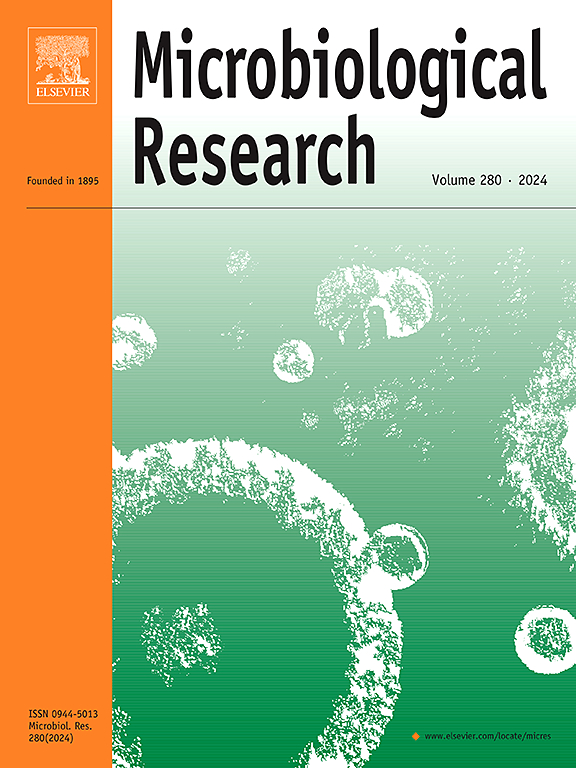Characterization of a novel antioxidant exopolysaccharide from an intestinal-originated bacteria Bifidobacterium pseudocatenulatum Bi-OTA128
IF 6.1
1区 生物学
Q1 MICROBIOLOGY
引用次数: 0
Abstract
Microbial exopolysaccharides (EPSs) have attracted extensive attention for their biological functions in antioxidant activities. In this study, we characterized a novel EPS produced by Bifidobacterium pseudocatenulatum Bi-OTA128 which exhibited the highest antioxidant capacity compared to nine other ropy bacterial strains, achieving 76.50 % and 93.84 % in DPPH· and ABTS·+ scavenging activity, and ferric reducing power of 134.34 μM Fe2+. Complete genomic analysis identified an eps gene cluster involved in the EPS biosynthesis of Bi-OTA128 strain, which might be responsible for its ropy phenotype. The EPS was then isolated and purified by a DEAE-Sepharose Fast Flow column. A single elution part EPS128 was obtained with a recovery rate of 43.5 ± 1.78 % and a total carbohydrate content of 93.6 ± 0.76 %. Structural characterization showed that EPS128 comprised glucose, galactose, and rhamnose (molar ratio 4.0:1.2:1.1), featuring a putative complex backbone structure with four branched chains and an unusual acetyl group at O-2 of terminal rhamnose. Antioxidant assay in vitro indicated that EPS128 exhibited antioxidant potential with 50.52 % DPPH· and 65.40 % ABTS·+ scavenging activities, reaching 54.3 % and 70.44 % of the efficacy of standard Vitamin C at 2.0 mg/L. Furthermore, EPS128 showed protective effects against H2O2-induced oxidative stress in HepG2 cells by reducing cellular reactive oxygen species (ROS) and increasing cell viability. These findings present the first comprehensive report of an antioxidant EPS from B. pseudocatenulatum, highlighting its potential as a natural antioxidant for applications in the food industry and clinical settings.
肠源性双歧杆菌Bi-OTA128新型抗氧化外多糖的特性鉴定
微生物外多糖(EPSs)因其在抗氧化方面的生物功能而受到广泛关注。在这项研究中,我们对双歧杆菌 Bi-OTA128 产生的一种新型 EPS 进行了表征。与其他 9 株嗜腐菌相比,这种 EPS 表现出最高的抗氧化能力,DPPH- 和 ABTS-+ 清除活性分别达到 76.50 % 和 93.84 %,铁还原力达到 134.34 μM Fe2+。完整的基因组分析确定了一个参与 Bi-OTA128 菌株 EPS 生物合成的 Eps 基因簇,这可能是造成其多腐表型的原因。然后用 DEAE-Sepharose 快速流动柱分离纯化了 EPS。单一洗脱部分 EPS128 的回收率为 43.5 ± 1.78 %,总碳水化合物含量为 93.6 ± 0.76 %。结构表征显示,EPS128 由葡萄糖、半乳糖和鼠李糖组成(摩尔比为 4.0:1.2:1.1),具有四条支链的假定复合骨架结构,末端鼠李糖的 O-2 位有一个不寻常的乙酰基。体外抗氧化试验表明,EPS128 具有抗氧化潜力,其 DPPH- 清除率为 50.52%,ABTS-+ 清除率为 65.40%,分别达到 2.0 毫克/升标准维生素 C 清除率的 54.3% 和 70.44%。此外,EPS128 通过减少细胞活性氧(ROS)和提高细胞活力,对 H2O2 诱导的 HepG2 细胞氧化应激具有保护作用。这些研究结果首次全面报道了来自假叶蝉属植物的抗氧化 EPS,凸显了其作为天然抗氧化剂在食品工业和临床应用方面的潜力。
本文章由计算机程序翻译,如有差异,请以英文原文为准。
求助全文
约1分钟内获得全文
求助全文
来源期刊

Microbiological research
生物-微生物学
CiteScore
10.90
自引率
6.00%
发文量
249
审稿时长
29 days
期刊介绍:
Microbiological Research is devoted to publishing reports on prokaryotic and eukaryotic microorganisms such as yeasts, fungi, bacteria, archaea, and protozoa. Research on interactions between pathogenic microorganisms and their environment or hosts are also covered.
 求助内容:
求助内容: 应助结果提醒方式:
应助结果提醒方式:


